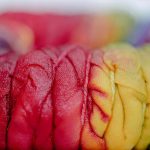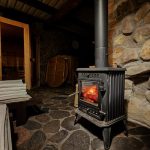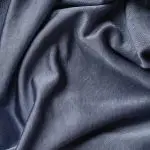When you pick fabrics for chef coats and kitchen uniforms, durability isn’t just a bonus—it’s a must. You need materials that can withstand constant washing, heat, and spills while keeping you comfortable during long shifts. But durability isn’t only about toughness; it’s also about how the fabric performs over time in a demanding environment. To make the right choice, consider what qualities truly matter in your daily kitchen wear.
Table of Contents
Key Takeaways
- Select poly-cotton blends for a balance of comfort, durability, and wrinkle resistance in chef coats.
- Opt for tightly woven fabrics like twill to enhance abrasion resistance and maintain shape after washing.
- Choose fabrics treated with stain and moisture repellents to extend uniform lifespan in busy kitchens.
- Prioritize moisture-wicking and breathable materials to maintain comfort without sacrificing durability.
- Evaluate fabric quality by considering environmentally produced textiles known for superior durability and performance.
Understanding Fabric Types for Chef Coats
Anyone choosing a chef coat should understand the fabric options available.
You’ll find that fabric characteristics like breathability, durability, and stain resistance vary widely. Common materials include cotton, polyester, and their fabric blends.
Cotton offers excellent comfort and breathability but can wrinkle easily. Polyester, on the other hand, provides durability and resists stains, making it easier to maintain.
Cotton is comfy and breathable, while polyester adds durability and resists stains for easy care.
Fabric blends combine the best of both worlds—poly-cotton blends, for example, balance comfort with toughness and reduce shrinking and wrinkling.
By knowing these fabric characteristics and blends, you can pick a chef coat that suits your kitchen’s demands without sacrificing comfort or longevity.
Understanding these basics helps you make an informed choice, ensuring your coat stands up to the rigors of daily use.
Key Comfort and Performance Features to Consider
When choosing a chef coat, you’ll want fabrics that wick moisture away to keep you dry and comfortable.
Breathability is essential for staying cool in hot kitchens, so look for materials that allow air to flow easily.
Plus, lightweight and flexible fabrics help you move freely without feeling weighed down.
Moisture-Wicking Fabric Benefits
Because kitchens can get hot and hectic, choosing chef coats with moisture-wicking fabric keeps you dry and comfortable throughout your shift.
This fabric excels in moisture management, pulling sweat away from your skin and speeding up evaporation. It guarantees enhanced comfort, preventing that sticky, clammy feeling during long hours.
Here are three key benefits of moisture-wicking fabrics for your chef coat:
- Stay Dry Longer: Quickly moves moisture away, keeping you dry even during intense kitchen rushes.
- Reduce Skin Irritation: Limits dampness, which helps prevent chafing and discomfort.
- Maintain Professional Appearance: Helps your coat look fresh and clean by reducing visible sweat stains.
Choosing moisture-wicking fabric means you can focus on cooking without distractions from sweat and discomfort.
Breathability for Hot Kitchens
Moisture-wicking fabrics help you stay dry, but breathability takes comfort a step further by allowing air to circulate and heat to escape. When working in hot kitchens, fabric ventilation is essential for effective heat management. Breathable fabrics reduce sweat buildup, prevent overheating, and keep you comfortable during long shifts.
| Feeling | Fabric Ventilation | Heat Management |
|---|---|---|
| Cool & Fresh | High airflow | Rapid heat escape |
| Comfortable | Balanced airflow | Moderate heat control |
| Overheated | Poor airflow | Trapped heat |
| Sticky & Uncomfortable | No airflow | Heat retention |
Choose fabrics with excellent ventilation to enhance your comfort and performance throughout intense kitchen hours.
Lightweight and Flexible Materials
Although durability is essential, you’ll also want chef coat fabrics that feel light and move easily with you.
Lightweight and flexible materials enhance your comfort during long shifts, allowing you to focus on your craft without feeling restricted.
Look for fabrics that feature stretchable weaves and soft textures to provide both resilience and ease of movement.
Here are three key features to evaluate:
- Stretchable Weaves – Fabrics with built-in stretch adapt to your movements, preventing tears and discomfort.
- Soft Textures – Smooth, gentle fabrics reduce irritation and keep you comfortable all day.
- Lightweight Construction – Lighter fabrics improve breathability and reduce fatigue, essential in hot kitchen environments.
Choosing these materials guarantees your chef coat supports both durability and flexibility.
Factors That Impact Durability and Longevity
When you choose fabrics for chef coats, several key factors influence how long they last and withstand daily wear.
First, fabric composition plays an essential role; blends like cotton-polyester often offer a balance of comfort and strength, resisting tears and stains better than pure cotton.
Next, consider the environmental impact—fabrics produced sustainably tend to be more durable because they’re often made with higher-quality fibers and better manufacturing processes.
Additionally, tightly woven fabrics resist abrasion and maintain their shape after repeated washing, extending your coat’s lifespan.
You should also look for materials treated to repel stains and moisture, reducing wear caused by spills and frequent cleaning.
Choosing the Right Fit and Style for Kitchen Uniforms
Durability matters, but fit and style play a big role in how comfortable and confident you feel in your kitchen uniform.
When choosing your chef coat or kitchen attire, consider these key points to guarantee the perfect fit and style:
- Fit Adjustment: Look for uniforms with adjustable features like side tabs or stretch panels. They allow you to tailor the fit, preventing discomfort during long shifts.
- Style Preferences: Choose a style that reflects your personality and workplace culture. Whether classic double-breasted or modern slim-fit, your choice impacts confidence.
- Mobility: Confirm the design supports easy movement. Fabrics combined with a smart cut can enhance comfort without sacrificing durability.
Maintenance and Care Tips for Long-Lasting Fabrics
You’ll want to follow easy washing practices to keep your chef coat looking sharp and lasting longer.
Pay attention to fabric care techniques, like using the right water temperature and avoiding harsh detergents.
These simple steps make a big difference in preserving your coat’s durability.
Easy Washing Practices
Although durable fabrics can withstand frequent washing, proper care is vital to keep your chef coats looking fresh and professional.
Adopting easy washing practices not only preserves the fabric’s integrity but also saves you time and effort. Here are three simple tips for effective fabric care:
- Sort properly: Separate whites and colors to prevent staining and maintain brightness.
- Use mild detergents: Choose gentle, bleach-free detergents to protect fibers and colors without compromising cleanliness.
- Avoid high heat: Wash in cold or warm water and air dry or tumble dry on low to prevent shrinking and fabric damage.
Following these easy washing habits guarantees your kitchen uniforms last longer and stay in top condition, making your maintenance routine hassle-free.
Fabric Care Techniques
When you want your chef coats to endure daily wear and frequent washing, following proper fabric care techniques makes all the difference. Focus on gentle fabric cleaning and timely stain removal to keep uniforms looking fresh and lasting longer. Avoid harsh detergents and bleach, which can weaken fibers. Instead, pre-treat stains promptly with suitable stain removers. Wash in cold water to prevent shrinkage and color fading. Air drying or low-heat tumble drying preserves fabric integrity.
| Care Step | Tip |
|---|---|
| Pre-treat stains | Use gentle stain removers |
| Washing | Cold water, mild detergent |
| Drying | Air dry or low heat |
| Ironing | Use appropriate heat settings |
| Storage | Hang to avoid wrinkles |
Customization Options to Enhance Uniform Functionality
Since chef coats need to withstand the demands of a busy kitchen, customizing them can greatly boost their practicality.
You can tailor your uniforms not just for style but for real function. Here are three ways to enhance your chef coat’s usability:
- Custom embroidery options let you add names, logos, or roles, making identification easy and adding a professional touch.
- Functional pocket designs offer space for tools, thermometers, or pens, keeping essentials within reach without slowing you down.
- Reinforced stitching and adjustable closures improve durability and comfort, adapting to your movements during long shifts.
Balancing Cost and Quality in Fabric Selection
Finding the right fabric for your chef coats means balancing cost with quality to confirm durability without overspending. To make smart choices, focus on cost effective options that still meet a thorough quality assessment. Consider fabrics that offer longevity, ease of care, and comfort without breaking your budget.
| Fabric Type | Cost and Quality Notes |
|---|---|
| Polyester Blend | Affordable, wrinkle-resistant |
| Cotton | Comfortable, moderate durability |
| Poly-Cotton | Balanced cost, good durability |
| Twill | Higher cost, excellent wear resistance |
Evaluate your kitchen’s needs and pick fabrics that deliver value for money. By balancing cost and quality, you confirm your chef coats last longer and perform better, saving you money in the long run.
Frequently Asked Questions
Can Chef Coats Be Made From Sustainable or Eco-Friendly Fabrics?
Picture the soft touch of organic cotton or the sleek feel of recycled polyester. You can absolutely choose chef coats made from these sustainable, eco-friendly fabrics that blend durability with care for the planet in every stitch.
How Do Fabric Blends Affect Allergenic Reactions in Sensitive Skin?
You’ll find fabric blends can trigger allergenic reactions if they contain irritants. Choosing allergen free materials helps protect sensitive skin, reducing rashes or discomfort. Always opt for hypoallergenic, natural fibers to keep your skin safe.
Are There Fabrics That Offer Flame Resistance for Kitchen Safety?
Think of flame retardant materials as shields that protect you from kitchen fires. You’ll want fabrics meeting kitchen safety standards—like treated cotton or Nomex—that resist flames, keeping you safe while you work amidst the heat and sparks.
What Innovations Exist in Fabric Technology for Kitchen Uniforms?
You’ll find smart textiles with moisture-wicking technology that keep you dry and comfortable during long shifts. These innovative fabrics also offer enhanced durability and stain resistance, making your kitchen uniform both functional and long-lasting.
How Do Fabric Choices Impact the Environmental Footprint of Uniforms?
You impact the environment by choosing fabrics with sustainable sourcing and a long fabric lifecycle. Opting for eco-friendly materials reduces waste and energy use, making your uniforms greener and minimizing their overall environmental footprint.
- How to Choose Chemical-Free Flame-Retardant Fabrics for Baby Rooms - June 8, 2025
- Which Fabrics Offer Natural Fire Resistance for Upholstery? - June 8, 2025
- Are There Naturally Flame-Retardant Fabrics for Curtains? - June 8, 2025







